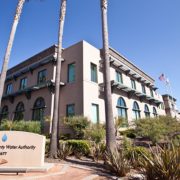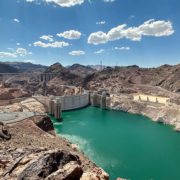The long-running debate over whether the Fallbrook and Rainbow communities should leave the San Diego County Water Authority to obtain cheaper rates ignores a very large elephant in the room — climate change.
If the two rural communities cast their lot with Riverside County, their agricultural economy will depend upon the Colorado River and the State Water Project, both of which have been reeling from increasingly severe droughts.
In December, just six months before the two communities’ case was heard by the Local Agency Formation Commission, the State Water Project announced that for the second year in a row, it would provide only 5% of requested water allocations.
Unexpectedly heavy winter rains then saved California, but not the Colorado River basin, where Lake Mead, the nation’s largest reservoir, remains 165 feet below its historic full level.
In May, the Western states that tap the Colorado River agreed to a reductions of up to 30% in water allocations. That’s a lot, and it’s not clear it is enough to save Lake Mead in the long run.
So Fallbrook and Rainbow are taking a risk. It’s a risk that was noted, albeit only briefly and obliquely, in the LAFCO proceedings.
“The superior reliability of SDCWA’s supply has benefitted FPUD and RMWD in the past … In switching from being wholesale customers of SDCWA to EMWD, FPUD and especially RMWD may face some challenges,” according to the official report for LAFCO.
Those “challenges” during a future drought could be a major reduction in water supply and higher prices at a time when the rest of San Diego County, thanks to the desalination plant, water recycling and the giant San Vicente Reservoir, has plenty of water.
Fallbrook and Rainbow say they don’t really benefit from this reliability, since their water systems are not directly connected. But water is a fungible resource. The two districts do have direct access to Colorado River water earmarked for San Diego County.
If the rest of San Diego County needs less Colorado water because of the investment in local supplies, then that water can be diverted to Fallbrook and Rainbow during a drought. And that’s exactly what happened during the most recent one. In any case, the Water Authority has plans for a physical connection, though it backed off amid the dispute.
Climate change impacts
There’s a whiff of national politics in all this. These are conservative communities where some may doubt climate change, and local business leaders have criticized desalination as a boondoggle. If you sincerely do not believe the climate is changing, then maybe you don’t see a risk in changing water suppliers.
In many ways this controversy is a bellwether for future wrangles over resources amid climate change. Do we stick with the old ways — in this case tapping our lakes and rivers — and hope for the best, or do we continue to invest in alternatives to protect our future?
It’s expensive to build desalination plants, recycling projects and new reservoirs, just like it’s expensive to upgrade the electrical grid and install car chargers. But a changing climate doesn’t ask for permission to impact our lives.
(Editor’s Note: Chris Jennewein is editor and publisher of Times of San Diego.)





